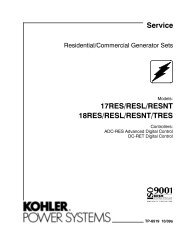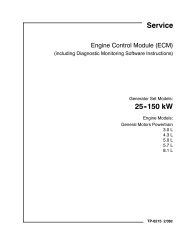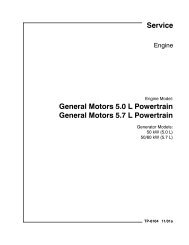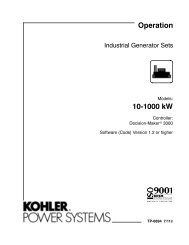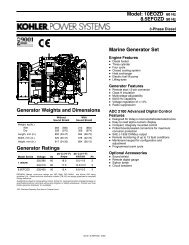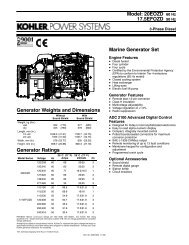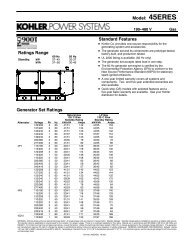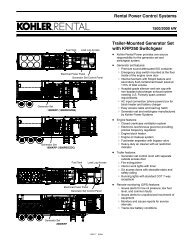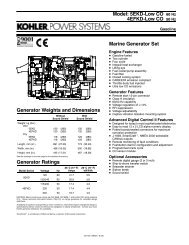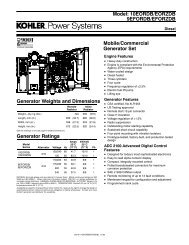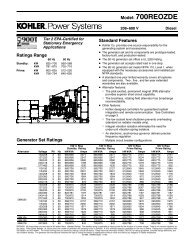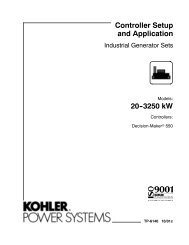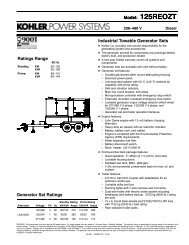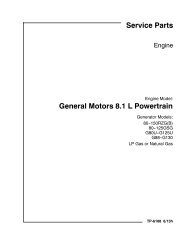Service Manual, General Motors 4.3L Engine (TP ... - Kohler Power
Service Manual, General Motors 4.3L Engine (TP ... - Kohler Power
Service Manual, General Motors 4.3L Engine (TP ... - Kohler Power
You also want an ePaper? Increase the reach of your titles
YUMPU automatically turns print PDFs into web optimized ePapers that Google loves.
<strong>Engine</strong> Marine/Industrial <strong>4.3L</strong> 6-13<br />
Valve Train Diagnosis<br />
<strong>General</strong> Information<br />
Symptoms Cause<br />
A light tapping noise at 1/2 engine speed, or any varying frequency, may indicate a valve train problem.<br />
Tapping noises will typically increase with increased engine speed.<br />
Before attempting to diagnose a valve train noise, check for the proper engine oil level and then allow the engine to<br />
obtain normal operating temperature.<br />
Following this procedure will bring all engine components to a normal state of expansion.<br />
Sit in the driver’s seat, then operate the engine at various speeds and listen for any abnormal engine noise.<br />
Valve Train Noise Low engine oil pressure<br />
A worn or faulty oil pump<br />
A loose or plugged oil pump screen<br />
Loose valve rocker arm attachments (causing excessive valve lash)<br />
A worn or damaged valve rocker arm ball<br />
A worn valve rocker arm and/or valve pushrod<br />
A broken valve spring<br />
Sticking valves<br />
Valve lifters worn, dirty or faulty<br />
A broken valve lifter guide<br />
<strong>Engine</strong> camshaft lobes worn<br />
Worn valve guides or valve stems<br />
Bent valve pushrods<br />
Excessive free play in the camshaft timing chain<br />
Bent, broken or damaged camshaft sprocket teeth<br />
Diagnostic Table<br />
Step Action Value(s) Yes No<br />
DEFINITION: A light tapping noise at 1/2 engine speed, or any varying frequency.<br />
1 Is there valve train noise? — Go to Step 2 System OK<br />
Check for a high engine oil level. An engine with the<br />
engine oil level above the FULL mark on the oil level<br />
indicator allows the crankshaft counterweights to churn the<br />
2 engine oil into foam. When the foamy engine oil is pumped<br />
into the valve lifters, the valve lifters become noisy. A solid<br />
column of engine oil ensures proper valve lifter operation.<br />
Is the engine oil level too high? — Go to Step 3 Go to Step 4<br />
3<br />
Drain the engine oil to the proper level.<br />
Is the tapping noise gone? — System OK Go to Step 6<br />
Check for a low engine oil level. An engine with the engine<br />
oil level below the ADD mark on the oil level indicator may<br />
4 allow the oil pump to pump air at high engine RPM.<br />
Is the engine oil level below the ADD mark on the oil level<br />
indicator? — Go to Step 5 Go to Step 6<br />
5<br />
6<br />
Add the engine oil as required.<br />
Is the tapping noise gone? — System OK Go to Step 6<br />
Check for the proper engine oil pressure. Refer to <strong>Engine</strong><br />
Mechanical Specifications and Oil Pressure Diagnosis and<br />
41.4 kPa<br />
Testing.<br />
(6 psi)<br />
Is the engine oil pressure within specifications? Go to Step 11 Go to Step 7<br />
2000 Marine/Industrial



